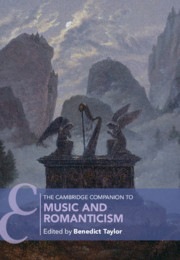Book contents
- The Cambridge Companion to Music and Romanticism
- Cambridge Companions to Music
- The Cambridge Companion to Music and Romanticism
- Copyright page
- Contents
- Figures
- Tables
- Musical Examples
- Contributors
- Preface
- Chronology
- Part I Horizons
- Part II Worlds
- Part III Aesthetics
- Part IV Practices
- 14 Romantic Languages
- 15 Romantic Forms
- 16 Romanticism and the Ideal of Song
- 17 Music Staged and Unstaged
- 18 Romanticism and Performance
- Part V Histories
- Select Bibliography
- Index
- References
14 - Romantic Languages
from Part IV - Practices
Published online by Cambridge University Press: 06 August 2021
- The Cambridge Companion to Music and Romanticism
- Cambridge Companions to Music
- The Cambridge Companion to Music and Romanticism
- Copyright page
- Contents
- Figures
- Tables
- Musical Examples
- Contributors
- Preface
- Chronology
- Part I Horizons
- Part II Worlds
- Part III Aesthetics
- Part IV Practices
- 14 Romantic Languages
- 15 Romantic Forms
- 16 Romanticism and the Ideal of Song
- 17 Music Staged and Unstaged
- 18 Romanticism and Performance
- Part V Histories
- Select Bibliography
- Index
- References
Summary
The analogy between music and language is both problematic and essential for any rich understanding of musical Romanticism. Few commentators today would accept that music functions as a language; but the idea that music has poetic, literary, or dramatic substance is foundational to Romantic aesthetics and find expression in music as stylistically disparate as Berlioz’s Symphonie fantastique and Schumann’s Papillons. This chapter explores the musical languages of Romanticism, focusing both on the melodic, harmonic, and formal dimensions of musical practice and on the literary and linguistic labour they perform. It explores music from Beethoven and Field at the turn of the nineteenth century to Brahms and Mussorgsky at the century’s end, paying attention to the contrasted thematic cultures that Beethoven and Field instantiate, the harmonic innovations of Schubert, Liszt, Brahms, and Mussorgsky, and the intersections of form and narrative in Schumann’s Second Symphony.
- Type
- Chapter
- Information
- The Cambridge Companion to Music and Romanticism , pp. 231 - 257Publisher: Cambridge University PressPrint publication year: 2021

